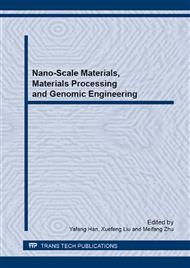p.169
p.174
p.178
p.183
p.188
p.194
p.201
p.205
p.209
Cellulose Nanofiber-Supported Polyaniline Nanocomposite Conductive Film and its Conductive Properties
Abstract:
As a conducting polymer, polyaniline (PANI) have found wide applications including electrode material, sensors and supercapacitors, which is attributed to a combination of the advantages for both organic semiconductors and nanomaterials. This article concentrates on the preparation of bacteria cellulose-polyaniline (BC/PANI) conducting nanocomposite films via in situ polymerization of anailine onto bacteria cellulose (BC) scaffold. A series of nanocomposites were prepared with different anailine concentration, doping acid concentration and molar ratio of monomer and oxidant. The as-prepared conducting nanocomposites were characterized by conductivity measurement, scanning electronic microscope (SEM), fourier transform infrared spectroscopy (FT-IR), thermogravimetric analyser (TGA), etc, to find out the best preparation conditions. The results indicated that PANI coated on the surface of nanofibers of bacterial cellulose, the nanoconductive path formed and the conductivity of the film ranged from 2.0×10-8 to 0.24 S·cm-1. In addition, the method of combining organic and inorganic acids can solve the de-doped problem caused by using traditional inorganic small molecule acid, such as HCl.
Info:
Periodical:
Pages:
188-193
Citation:
Online since:
April 2014
Authors:
Price:
Сopyright:
© 2014 Trans Tech Publications Ltd. All Rights Reserved
Share:
Citation:


